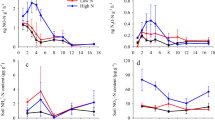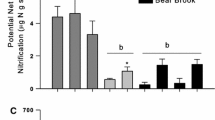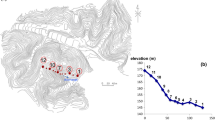Abstract
Application of nitrate fertilizers on two types of forest soils led to a marked increase in the NO emission rate indicating a large potential for NO production in these soils. The largest fluxes on the fertilized plots were up to 60 ng NO−N m−2 s−1. About 0.35% of the applied nitrogen was lost as NO within about 14 days after fertilization. The fluxes from the unfertilized forest soils were in the range 0.1 to 0.8 ng NO−N m−2 s−1 with a median value of 0.3 ng NO−N m−2 s−1. If this value, obtained during June and August to September, is representative for the growing season (150 days), it corresponds to an annual emission of 0.04 kg NO−N ha−1. This is about 30% of the value obtained for an unfertilized agricultural soil. Because of the large areas occupied by forests in Sweden the flux of NO from forest soils represents a significant contribution to the total flux of NO from soils in Sweden.
Earlier observations of equilibrium concentrations for NO have been verified. These were found to range from 0.2 to 2 ppbv for an unfertilized forest soil and up to 170 ppbv for a fertilized soil. At the rural site in Sweden where these measurements were performed the ambient concentrations where found to be less than this equilibrium concentration, and consequently there was generally a net emission of NO.
There are still large uncertainties about the global flux of NO from soils. Using direct measurements on three different types of ecosystems and estimates based on a qualitative discussion for the remaining land areas, a global natural source for NO of the order of 1 Tg N a−1 was obtained. If 0.35% of the total annual production of fertilizer nitrogen is lost as NO, fertilization of soils may contribute with 20% to the natural flux from soils.
Similar content being viewed by others
References
Axelsson, B. and Bråkenhielm, S., 1980, Investigation sites of the Swedish Coniferous Forest Project—biological and physiographical features, in T. Persson (ed.),Structure and Function of Northern Coniferous Forests—An Ecosystem Study, Ecol. Bull. (Stockholm), Vol. 32, pp. 25–64.
Bolin, B., Degens, E. T., Duvigneaud, P., and Kempe, S., 1979, The global biogeochemical carbon cycle, in B.Bolin, E. T.Degens, S.Kempe, and P.Ketner (eds.)The Global Carbon Cycle. SCOPE 13, Wiley, Chichester, New York, Brisbane, Toronto, pp. 1–56.
Bundy, L. G. and Bremner, J. M., 1974, Effects of nitrification inhibitors on transformation of urea nitrogen in soils,Soil Biol. Biochem. 6, 369–375.
Conrad, R., Seiler, W., and Bunse, G., 1983, Factors influencing the loss of fertilizer nitrogen into the atmosphere as N2O,J. Geophys. Res. 88, 6709–6718.
Crutzen, P. J., 1983, Atmospheric interactions — Homogeneous gas reactions of C, N and S containing compounds, in B.Bolin and R. B.Cook (eds.), The Major Biogeochemical Cycles and their Interactions, SCOPE 21, Wiley, Chichester, New York, Brisbane, Toronto, Singapore, pp. 67–112.
Ehhalt, D. H. and Drummond, J. W., 1982, The tropospheric cycle of NO x , in H. W. Georgii and W. Jaeschke (eds.),Chemistry of the Unpolluted and Polluted Troposphere, Proceedings of the NATO Advanced Study Institute, Corfu, Greece, October, 1981, pp. 219–251.
Food and Agriculture Organization (FAO) of the U.N., 1979,Agriculture: Toward 2000, Conference C/79/27, Rome, FAO, pp. 30–31.
Galbally, I. E., Freney, J. R., Denmead, O. T., and Roy, C. R., 1980, Processes controlling the nitrogen cycle in the atmosphere over Australia, inProc. Forth Internat. Symp. Environ. Biogeochem., Canberra, Australia, 26 August to 4 September, 1979, pp. 319–325.
Galbally, I. E. and Roy, C. R., 1978, Loss of fixed nitrogen from soils by nitric oxide exhalation,Nature 275, 734–735.
Galbally, I. E. and Roy, C. R., 1981, Ozone and nitrogen oxides in the Southern Hemisphere troposphere,Proc. Quadrennial Internat. Ozone Symp., Boulder, Colorado, August 1980, pp. 431–438.
Johansson, C. and Galbally, I. E., 1984, Production of nitric oxide in a loam under aerobic and anaerobic conditions,Appl. Environ. Microbiol., in press.
Johansson, C. and Granat, L., 1984, Emission of nitric oxide from arable land,Tellus 36B, 26–37.
Keeney, D. R., Fillery, I. R., and Marx, G. P., 1979, Effect of temperature on the gaseous nitrogen products of denitrification in a silt loam soil,Soil Sci. Soc., Am. J. 43, 1124–1128.
Kim, C. M., 1973, Influence of vegetation types on the intensity of ammonia and nitrogen dioxide liberation from soil,Soil Biol. Biochem. 5, 163–166.
Laudelout, H., Germain, L., Chabalier, P. F., and Chiang, C. N., 1977, Computer simulation of loss of fertilizer nitrogen through chemical decomposition of nitrite,J. Soil Sci. 28, 329–339.
Lipschultz, F., Zafirou, O. C., Wofsy, S. C., McElroy, M. B., Valois, F. W., and Watson, S. W., 1981, Production of NO and N2O by soil nitrifying bacteria,Nature 294, 641–643.
Logan, J. A., Prather, M. J., Wofsy, S. C., and McElroy, M. B., 1981, Tropospheric chemistry: A global perspective,J. Geophys. Res. 86, 7210–7254.
Marshall, V. G. and Debell, D. S., 1980, Comparison of four methods of measuring volatilization losses of nitrogen following urea fertilization of forest soils,Can. J. Soil Sci. 60, 549–563.
McKenney, D. J., Shuttleworth, K. F., Vriesacker, J. R., and Findlay, W. I., 1982, Production and loss of nitric oxide from denitrification in anaerobic Brookston Clay,Appl. Environ. Microbiol. 43, 534–541.
Pereira, J., 1982, Nitrogen cycling in South American savannas,Plant Soil 67, 293–304.
Sanhueza, E., 1982, The role of the atmosphere in nitrogen cycling,Plant Soil 67, 61–71.
Söderlund, R. and Rosswall, T., 1982, The nitrogen cycle, in O.Hutzinger, (ed.), The Handbook of Environmental Chemistry. Vol. 1, part B, Springer-Verlag, Berlin, Heidelberg, New York, pp. 61–81.
Söderlund, R., 1980, Aspects of nitrogen cycling from an atmospheric chemist's viewpoint, in T. Rosswall (ed.),Nitrogen Cycling in West African Ecosystems, Proceedings of a workshop, Ibadan, Nigeria, 11–15 December, 1978 pp. 23–29.
Söderlund, R. and Svensson, B. H., 1976, The global nitrogen cycle, in B. H. Svensson and R. Söderlund (eds.),Nitrogen, Phosphorus and Sulphur—Global Cycles, SCOPE report no. 7, Ecol. Bull. (Stockholm)22, 23–77.
Steen, W. C. and Stojanovic, B. J., 1971, Nitric Oxide volatilization from a calcareous soil and model aqueous solutions,Soil Sci. Soc. Am. Proc.,35, 277–283.
Technicon Industrial Systems, 1973,Nitrate and Nitrite in Water and Wastewater, Method No. 100–70W, Technicon Instrum. Corp., Tarrytown, N.Y.
Author information
Authors and Affiliations
Rights and permissions
About this article
Cite this article
Johansson, C. Field measurements of emission of nitric oxide from fertilized and unfertilized forest soils in Sweden. J Atmos Chem 1, 429–442 (1984). https://doi.org/10.1007/BF00053804
Received:
Revised:
Issue Date:
DOI: https://doi.org/10.1007/BF00053804




